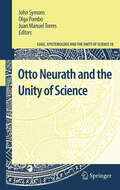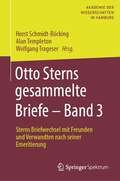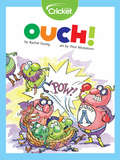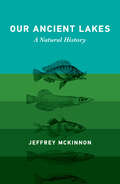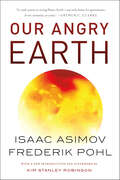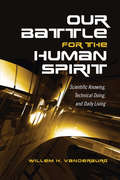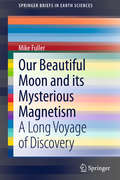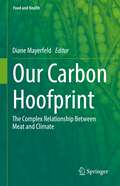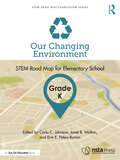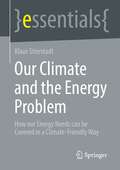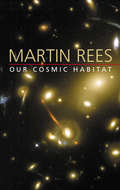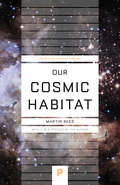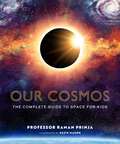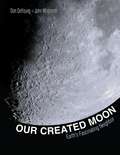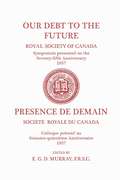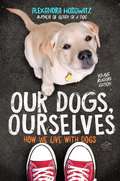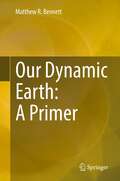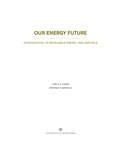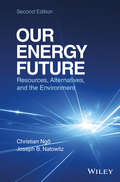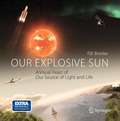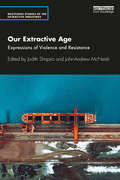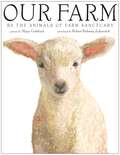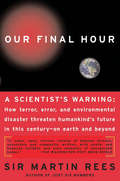- Table View
- List View
Otto Neurath and the Unity of Science
by Olga Pombo John Symons Juan Manuel TorresThis volume critically reexamines Otto Neurath's conception of the unity of science. Some of the leading scholars of Neurath's work, along with many prominent philosophers of science critically examine his place in the history of philosophy of science and evaluate the relevance of his work for contemporary debates concerning the unity of science.
Otto Sterns gesammelte Briefe – Band 3: Sterns Briefwechsel mit Freunden und Verwandten nach seiner Emeritierung
by Horst Schmidt-Böcking Alan Templeton Wolfgang TrageserIn diesem mehrbändigen Werk finden sich die Briefwechsel des bedeutenden Physikers und Nobelpreisträgers Otto Stern (1888–1969). Das Besondere an dieser Sammlung ist, dass die einzelnen Bände nicht streng chronologisch, sondern nach Themen und Personen angeordnet sind, um je einen Themenschwerpunkt im Leben Sterns im Zusammenhang vorzustellen. Erklärende Texte zwischen den Briefen ermöglichen ein tieferes Verständnis der wissenschaftlichen und historischen Zusammenhänge. Das Werk richtet sich damit nicht nur an Wissenschaftshistoriker, sondern an alle interessierten Leser, die mehr über Otto Stern und sein Wirken erfahren möchten.Im vorliegenden dritten Band werden im Wesentlichen seine Briefe nach seiner Emeritierung im Jahre 1945 vorgestellt. Aus der Zeit davor werden noch einige dienstliche Briefe mit Universitätsverwaltungen, seine Konferenzbesuche betreffend, aufgeführt. Die Darstellung der Briefe in diesem Band erfolgt in chronologischer Reihenfolge und zeigt eine wichtige Seite des Menschen Otto Stern.Sie belegen seine rege Teilnahme an nationalen und internationalen wissenschaftlichen Veranstaltungen und Konferenzen und zeigen Sterns große internationale Bedeutung bei der Entstehung der modernen Quantenphysik. Viele Briefe aus der Nachkriegszeit dokumentieren seine zahlreichen und langen Gastaufenthalte in der von ihm geliebten Schweiz. Der Briefwechsel der letzten Jahre seines Lebens stellt ein schrittweises Abschiednehmen dar, das gekennzeichnet ist durch den weiterhin gepflegten lebenslangen Kontakt zu bestimmten Personen, einigen Kollegen, Freunden und Verwandten. Mit diesem Werk soll an den herausragenden Physiker und Menschen Otto Stern erinnert werden, der mit seinen genialen Experimentierverfahren Vater des Stern-Gerlach-Experiments war und zusammen mit Walther Gerlach dieses in genialer Weise durchführte. Dies war ein Meilenstein für die Entwicklung der modernen Quantenphysik.
Ouch!
by Rachel YoungGetting shots may not be any fun, but these vaccinations prevent dangerous diseases. Learn how vaccinations help keep us healthy.
Our Ancient Lakes: A Natural History
by Jeffrey McKinnonThe unexpected diversity, beauty, and strangeness of life in ancient lakes—some millions of years old—and the remarkable insights the lakes are yielding about the causes of biodiversity.Most lakes are less than 10,000 years old and short-lived, but there is a much smaller number of ancient lakes, tectonic in origin and often millions of years old, that are scattered across every continent but Antarctica: Baikal, Tanganyika, Victoria, Titicaca, and Biwa, to name a few. Often these lakes are filled with a diversity of fish, crustaceans, snails, and other creatures found nowhere else in the world. In Our Ancient Lakes, Jeffrey McKinnon introduces the remarkable living diversity of these aquatic bodies to the general reader and explains the surprising, often controversial, findings that the study of their faunas is yielding about the formation and persistence of species. The first single-authored volume to synthesize studies of ancient lakes, Our Ancient Lakes provides an overview of the lakes and their distinctive geological origins; accounts of the evolutionary processes that have generated the incredible diversity found in the lakes and produced some of the fastest speciation rates known for vertebrates; the surprisingly important role of interspecies mating in the most rapid diversifications; the uniquely complete records of the creatures that inhabited the lakes, which are being extracted from deep lake sediments; the prospects for the lakes as we tumble into the Anthropocene; and much more.Shining a light on a class of biodiversity hot spot that is equivalent to coral reefs in the ocean or tropical rainforests on land, Our Ancient Lakes chronicles in a refreshingly personal and accessible way the often singular wonders of these venerable water bodies.The MIT Press gratefully acknowledges Furthermore: a program of the J.M. Kaplan Fund.
Our Angry Earth
by Isaac Asimov Frederik Pohl“A lucid overview of [environmental] problems and a compelling call to action.” —Publishers WeeklyFrom two of science fiction’s most celebrated and brilliant minds—Isaac Asimov and Frederik Pohl—comes the second edition of Our Angry Earth, a comprehensive analysis of today's environmental threats and a guide on how we can heal our planet, with an introduction and afterword from New York Times bestselling author Kim Stanley Robinson.Our Angry Earth provides a candid picture of the present and many possibilities for a better, cleaner future. From the greenhouse effect and depletion of our ozone layer to nuclear waste and species extinction, Asimov and Pohl not only present accessible explanations of complex scientific processes but ways we can improve our behavior and relationship with the planet, whether it be involvement in social activism or individual lifestyle changes.Kim Stanley Robinson, author of New York Times bestsellers 2312, New York2140, and the internationally renowned Mars trilogy, brings his decades-spanning expertise in climate change to Our Angry Earth’s introduction and afterword.At the Publisher's request, this title is being sold without Digital Rights Management Software (DRM) applied.
Our Battle for the Human Spirit: Scientific Knowing, Technical Doing, and Daily Living
by Willem H. VanderburgWestern society has become saturated with scientific and technological modes of thinking that impact our lives and our relationships. Expanding social inequality, the use of social media and the rise of mental illnesses such as anxiety and depression are manifestations of this shift in our civilization.Our Battle for the Human Spirit is a comprehensive probe into what is happening to human life in the beginning of the 21st century. It explores how culture, experience, and symbolization have been replaced by scientific, discipline-based, approaches. Willem H. Vanderburg argues that these approaches are inadequate in understanding the complexity of human lives and societies. In order to transcend these limits, Vanderburg calls for the reintegration of culture and symbolization into our daily lives.
Our Beautiful Moon and its Mysterious Magnetism
by Mike FullerThis book is a summary of the history of discovering the moon. The author has been involved in the Apollo program, working with its samples and this book covers these efforts. It describes the analysis methods of lunar samples and their interpretation to understand lunar paleomagnetism. The book has adopted an historical approach throughout, tracing the development of the ideas of the Earth-moon system, of the birth of the space age, of paleomagnetism and finally of lunar magnetism and its evidence for an early lunar dynamo.
Our Carbon Hoofprint: The Complex Relationship Between Meat and Climate (Food and Health)
by Diane MayerfeldIn the ongoing effort to combat global climate catastrophe, animal agriculture has long been a subject of contention. On the one hand, most agree that across the world increasing meat and dairy consumption are accelerating anthropogenic climate change. On the other hand, proponents of the livestock industry argue that modern advancements reduce greenhouse gas emissions from efficient livestock production to negligible quantities. Some even maintain that grass-based livestock production has a net positive impact on the environment, due to the carbon sequestration caused by grazing. Whom are we to believe? This book shows us that the answer is not so clear-cut. Beginning with the implications of the UN’s Livestock’s Long Shadow report, it breaks down the blind spots and highlights the insights of the most prominent pro-meat arguments, as well as of the push for a global switch to vegetarianism. While advances in efficiency might reduce greenhouse gas emissions per unit of meat or milk produced, attendant decreases in cost can enable overconsumption and thus produce more waste. And while carbon sequestration is beneficial, it is not a reliable cure-all for the industry. Due to the economics of farming, however, eliminating meat consumption may not even reduce emissions at all. The truth about livestock production is much more nuanced but, luckily, also far more holistic. The future of agricultural policy will have to take into consideration factors such as human health and economics, as well as climate. Eschewing ideology for empirical rigor, this book paves an actionable path forward for both consumers and producers, offering unique solutions for each livestock system and simple, everyday adjustments for the average omnivore.
Our Changing Environment, Grade K: STEM Road Map for Elementary School (STEM Road Map Curriculum Series)
by Carla C. Johnson Janet B. Walton Erin E. Peters-BurtonWhat if you could challenge your kindergartners to come up with a way to reduce human impact on the environment? With this volume in the STEM Road Map Curriculum Series, you can! Our Changing Environment outlines a journey that will steer your students toward authentic problem solving while grounding them in integrated STEM disciplines. Like the other volumes in the series, this book is designed to meet the growing need to infuse real-world learning into K–12 classrooms. This interdisciplinary, three-lesson module uses project- and problem-based learning to help students investigate the environment around them, with a focus on ways that humans can impact the environment. Working in teams, students will investigate various types of human impact on the environment (including pollution, littering, and habitat destruction), will participate in a classroom recycling program, and will explore the engineering design process as they devise ways to repurpose waste materials. To support this goal, students will do the following: Identify human impacts on the environment. Identify technological advances and tools that scientists use to learn about the changing environment, and use technology to gather data. Explain, discuss, and express concepts about the environment through development and design of a publication to report their scientific findings about the environment around the school. Chart and understand local weather patterns, and make connections between weather conditions and their observations of the environment. Identify and demonstrate recycling practices, including sorting materials and tracking amounts of materials recycled, and participate in a class recycling program. The STEM Road Map Curriculum Series is anchored in the Next Generation Science Standards, the Common Core State Standards, and the Framework for 21st Century Learning. In-depth and flexible, Our Changing Environment can be used as a whole unit or in part to meet the needs of districts, schools, and teachers who are charting a course toward an integrated STEM approach.
Our Changing World (Inspire Science, Grade K #Unit 2)
by McGraw-Hill EducationNIMAC-sourced textbook
Our Climate and the Energy Problem: How our Energy Needs can be Covered in a Climate-Friendly Way (essentials)
by Klaus StierstadtThis essential provides an overview of the changes in our climate, their causes and their consequences. Today, humanity's energy needs are largely met in ways that are harmful to the climate. The alternative to this, solar energy, would satisfy our needs thousands of times over. But this option is far too little used for mainly economic reasons. This essential then discusses the energy converters that can be used to make solar energy available. Some other modern energy sources, such as nuclear power, are either inadequate, still utopian, or otherwise environmentally harmful. An outlook shows that our energy problem could easily be solved with economic reason by global use of solar energy. The climate could thus still be stabilized in time.This book is a translation of the original German 1st edition Unser Klima und das Energieproblem by Klaus Stierstadt, published by Springer Fachmedien Wiesbaden GmbH, part of Springer Nature in 2020. The translation was done with the help of artificial intelligence (machine translation by the service DeepL.com). A subsequent human revision was done primarily in terms of content, so that the book will read stylistically differently from a conventional translation. Springer Nature works continuously to further the development of tools for the production of books and on the related technologies to support the authors.
Our Cosmic Habitat
by Martin ReesOur universe seems strangely ''biophilic,'' or hospitable to life. Is this happenstance, providence, or coincidence? According to cosmologist Martin Rees, the answer depends on the answer to another question, the one posed by Einstein's famous remark: ''What interests me most is whether God could have made the world differently.'' This highly engaging book explores the fascinating consequences of the answer being ''yes.'' Rees explores the notion that our universe is just a part of a vast ''multiverse,'' or ensemble of universes, in which most of the other universes are lifeless. What we call the laws of nature would then be no more than local bylaws, imposed in the aftermath of our own Big Bang. In this scenario, our cosmic habitat would be a special, possibly unique universe where the prevailing laws of physics allowed life to emerge.Rees begins by exploring the nature of our solar system and examining a range of related issues such as whether our universe is or isn't infinite. He asks, for example: How likely is life? How credible is the Big Bang theory? Rees then peers into the long-range cosmic future before tracing the causal chain backward to the beginning. He concludes by trying to untangle the paradoxical notion that our entire universe, stretching 10 billion light-years in all directions, emerged from an infinitesimal speck.As Rees argues, we may already have intimations of other universes. But the fate of the multiverse concept depends on the still-unknown bedrock nature of space and time on scales a trillion trillion times smaller than atoms, in the realm governed by the quantum physics of gravity. Expanding our comprehension of the cosmos, Our Cosmic Habitat will be read and enjoyed by all those--scientists and nonscientists alike--who are as fascinated by the universe we inhabit as is the author himself.
Our Cosmic Habitat
by Martin ReesOur universe seems strangely ''biophilic,'' or hospitable to life. Is this happenstance, providence, or coincidence? According to cosmologist Martin Rees, the answer depends on the answer to another question, the one posed by Einstein's famous remark: ''What interests me most is whether God could have made the world differently.'' This highly engaging book explores the fascinating consequences of the answer being ''yes.'' Rees explores the notion that our universe is just a part of a vast ''multiverse,'' or ensemble of universes, in which most of the other universes are lifeless. What we call the laws of nature would then be no more than local bylaws, imposed in the aftermath of our own Big Bang. In this scenario, our cosmic habitat would be a special, possibly unique universe where the prevailing laws of physics allowed life to emerge. Rees begins by exploring the nature of our solar system and examining a range of related issues such as whether our universe is or isn't infinite. He asks, for example: How likely is life? How credible is the Big Bang theory? Rees then peers into the long-range cosmic future before tracing the causal chain backward to the beginning. He concludes by trying to untangle the paradoxical notion that our entire universe, stretching 10 billion light-years in all directions, emerged from an infinitesimal speck. As Rees argues, we may already have intimations of other universes. But the fate of the multiverse concept depends on the still-unknown bedrock nature of space and time on scales a trillion trillion times smaller than atoms, in the realm governed by the quantum physics of gravity. Expanding our comprehension of the cosmos, Our Cosmic Habitat will be read and enjoyed by all those--scientists and nonscientists alike--who are as fascinated by the universe we inhabit as is the author himself.
Our Cosmos: The Complete Guide to Space for Kids
by Professor Raman PrinjaFrom planets and moons to black holes and asteroids, take a spectacular journey through the Universe with this definitive, illustrated guide for budding astronomers.Since the earliest moments of our civilization, space has captured the human imagination. Go on a tour of the Universe that is simply out of this world, taking in our planetary neighbors, our life-giving Sun, the awesome power of black holes, our nearby galaxies, and the creative power of stardust. See the passion of the people behind the space missions, the incredible inventions and spacecraft that allow us to see and travel farther than ever before, and, as humanity takes it first tentative steps towards these new worlds, be part of the journey that will define us forever.Discover everything you need to know about the ever-expanding universe in this must-have guide for children written by award-winning astrophysicist Professor Raman Prinja. With awe-inspiring illustrations by astrophysicist-turned-illustrator Suzie Mason.
Our Created Moon: Earth's Fascinating Neighbor
by Don DeYoung John WhitcombFor eons the moon has intrigued humanity. From its creation through the current issues of space exploration, the moon has been both a light in the night and a protective shield of earth placed perfectly by God, regulating our seasons and keeping our atmosphere purified. Billions of dollars have been spent to reach its surface and discover its secrets; open these pages and discover those secrets for yourself.
Our Debt to the Future: Royal Society of Canada, Symposium presented on the Seventy-fifth Anniversary 1957 (The Royal Society of Canada Special Publications #2)
by E.G.D. MurrayAT ITS ANNUAL MEETING in 1957, the Royal Society of Canada, celebrating the seventy-fifth anniversary of its foundation, departed from the accustomed pattern of its meetings. Instead of assembling in separate sections, Fellows from each Section of the Society were asked to contribute to a conspectus, focused by their specialized knowledge and trained discrimination, to reveal to the Society and to others certain trends and tendencies in Canada. Subjects and contributors are: "These Seventy-Five Years" (Presidential Address by W. A. Mackintosh); "The Roles of the Scientist and the Scholar in Canada's Future" (W. A. Mackintosh, David L. Thomson); "The Penalties of Ignorance of Man's Biological Dependence" (E. G. D. Murray, K. W. Neatby, I. McT. Cowan, G. H. Ettinger, R. H. Manske); "The Social Impact of Modern Technology" (N. A. M. MacKenzie, V. W. Bladen, E. W. R. Steacie, W. H. Watson); "Our Economic Potential in the Light of Science" (H. C. Gunning, J. E. Hawley, L. M. Pidgeon, B. S. Keirstead, Maurice Lamontagne); "Human Values and the Evolution of Society" (G.-H. Lévesque, T. W. M. Cameron, A. S. P. Woodhouse, R. Elie, Roy Daniells); "Let Us Look to Our Human Resources" (F. H. Underhill, J. K. W. Ferguson, L.-P. Dugal, W. B. Lewis). The volume is further prefaced by the address given by His Excellency the Right Honourable Vicent Massey, Governor-General of Canada, "The Weighing of Ayre."
Our Dogs, Ourselves -- Young Readers Edition: How We Live with Dogs
by Alexandra HorowitzThis middle grade adaptation of Our Dogs, Ourselves is an eye-opening, entertaining, and beautifully illustrated look about humans&’ complicated and sometimes contradictory relationship with man&’s best friend by New York Times bestselling author of Inside of a Dog—Young Readers Edition.We keep dogs and are kept by them. We love dogs and (we assume) we are loved by them. Even while we see ourselves in dogs, we also treat them in surprising ways. On the one hand, we let them into our beds, we give them meaningful names, make them members of our family, and buy them the best food, toys, accessories, clothes, and more. But we also shape our dogs into something they aren&’t meant to be. Purebreeding dogs has led to many unhealthy pups. Many dogs have no homes, or live out their life in shelters. How is it possible we can treat the same species in these two totally different ways? In Our Dogs, Ourselves Young Readers Edition, bestselling author of Inside of a Dog, Alexandra Horowitz reveals the odd, surprising, and contradictory ways we live with dogs.
Our Dynamic Earth: A Primer
by Matthew R. BennettStudents taking undergraduate degrees in geography, ecology, earth science, and environmental science frequently take an introductory unit in Physical Geography. Some will have not done any geography since their early teens, while others have more recent knowledge. This range of backgrounds can be challenging for both the instructor and the student, this primer aims to help. A primer is a readable introduction to a subject, more technical than a piece of popular science, but less detailed than a specialist textbook. It aims to give the reader a platform in a subject with which they may be unfamiliar, so that they can proceed simultaneously, or sequentially, to more advanced texts and information. Ideally the primer should have something for those without any knowledge, while also challenge and entertaining those who do. Not quite bedtime reading, but a step in that direction. Our Dynamic Earth introduces students to the Earth's origins, to plate tectonics, atmospheric and oceanographic circulation, as well as to a range of Earth surface processes. Idea to get you started in your studies.
Our Energy Future
by Stephen P. Mayfield Carla S. JonesOur Energy Future is an introductory textbook for the study of energy production, alternative and renewable fuels, and ways to build a sustainable energy future. Jones and Mayfield explore the creation and history of fossil fuels, their impact on the environment, and how they have become critical to our society. The authors also outline how adopting sustainable biofuels will be key to the future of energy stability and discuss a number of renewable energy options and biofuel feedstocks that are replacements for petroleum-based products. Our society is consuming energy at an alarming rate, and the authors warn that continuing fuel-usage patterns could permanently damage the environment. This book emphasizes the importance of continued scientific, agricultural, and engineering development while it outlines the political and environmental challenges that will accompany a complete shift from fossil fuels to renewable energy and biomass. Our Energy Future is an accessible resource for undergraduate students studying biofuels and bioenergy.
Our Energy Future
by Joseph Natowitz Christian NgoPresents an overview on the different aspects of the energy value chain and discusses the issues that future energy is facing This book covers energy and the energy policy choices which face society. The book presents easy-to-grasp information and analysis, and includes statistical data for energy production, consumption and simple formulas. Among the aspects considered are: science, technology, economics and the impact on health and the environment. In this new edition two new chapters have been added: The first new chapter deals with unconventional fossil fuels, a resource which has become very important from the economical point of view, especially in the United States. The second new chapter presents the applications of nanotechnology in the energy domain. Provides a global vision of available and potential energy sources Discusses advantages and drawbacks to help prepare current and future generations to use energy differently Includes new chapters covering unconventional fossil fuels and nanotechnology as new energy Our Energy Future: Resources, Alternatives and the Environment, Second Edition, is written for professionals, students, teachers, decision-makers and politicians involved in the energy domain and interested in environmental issues.
Our Explosive Sun
by Pal BrekkeThe Sun, which is our own star at the center of the Solar System, gives rise to all life on Earth and is the driver of photosynthesis in plants and the source of all food and energy for living things. As seen with the naked eye, the Sun appears as a static and quiet yellow disk in the sky. However, it is a stormy and ever-changing star that contributes much more than light and heat. For example, it is the source of the beautiful northern lights and can affect our technology-based society in many ways. Our Explosive Sun: A Visual Feast of our Source of Light and Life is a great introduction to the Sun for general readers as well as scientists who are not solar physicists. The book presents the basic properties of the Sun, describes how it has fascinated humans throughout history, and shows how it influences our current technologies. The book includes a large number of illustrations and video materials for SpringerExtras, along with a PowerPoint presentation that provides a useful resource for teachers and lectures.
Our Extractive Age: Expressions of Violence and Resistance (Routledge Studies of the Extractive Industries and Sustainable Development)
by Judith ShapiroOur Extractive Age: Expressions of Violence and Resistance emphasizes how the spectrum of violence associated with natural resource extraction permeates contemporary collective life. Chronicling the increasing rates of brutal suppression of local environmental and labor activists in rural and urban sites of extraction, this volume also foregrounds related violence in areas we might not expect, such as infrastructural developments, protected areas for nature conservation, and even geoengineering in the name of carbon mitigation. Contributors argue that extractive violence is not an accident or side effect, but rather a core logic of the 21st Century planetary experience. Acknowledgement is made not only of the visible violence involved in the securitization of extractive enclaves, but also of the symbolic and structural violence that the governance, economics, and governmentality of extraction have produced. Extractive violence is shown not only to be a spectacular event, but an extended dynamic that can be silent, invisible, and gradual. The volume also recognizes that much of the new violence of extraction has become cloaked in the discourse of "green development," "green building," and efforts to mitigate the planetary environmental crisis through totalizing technologies. Ironically, green technologies and other contemporary efforts to tackle environmental ills often themselves depend on the continuance of social exploitation and the contaminating practices of non-renewable extraction. But as this volume shows, resistance is also as multi-scalar and heterogeneous as the violence it inspires. The book is essential reading for activists and for students and scholars of environmental politics, natural resource management, political ecology, sustainable development, and globalization.
Our Farm: By the Animals of Farm Sanctuary
by Maya GottfriedMaya the cow, J.D. the piglet, Hilda the sheep, and a dozen more animals all speak directly to the reader, showing off their unique personalities in this wonderful collection of poems. Master watercolorist Robert Rahway Zakanitch provides a portrait that perfectly captures the essence of each creature. Together the poems and paintings add up to a picture of life on the friendliest farm around.Maya Gottfried based her poems on real animals from Farm Sanctuary, a safe haven for injured or abused farm animals with locations in New York and California.
Our Final Hour: How Terror, Error, and Environmental Disaster in This Century Threaten humankind's Future on Earth and Beyond
by Martin ReesWhat we might do to destroy ourselves.
Our Final Hour: How Terror, Error, and Environmental Disaster Threaten Humankind's Future in this Century--On Earth and Beyond
by Martin ReesA scientist known for unraveling the complexities of the universe over millions of years, Sir Martin Rees now warns that humankind is potentially the maker of its own demise--and that of the cosmos. Though the twenty-first century could be the critical era in which life on Earth spreads beyond our solar system, it is just as likely that we have endangered the future of the entire universe. With clarity and precision, Rees maps out the ways technology could destroy our species and thereby foreclose the potential of a living universe whose evolution has just begun. Rees boldly forecasts the startling risks that stem from our accelerating rate of technological advances. We could be wiped out by lethal "engineered" airborne viruses, or by rogue nano-machines that replicate catastrophically. Experiments that crash together atomic nuclei could start a chain reaction that erodes all atoms of Earth, or could even tear the fabric of space itself. Through malign intent or by mistake, a single event could trigger global disaster. Though we can never completely safeguard our future, increased regulation and inspection can help us to prevent catastrophe. Rees's vision of the infinite future that we have put at risk--a cosmos more vast and diverse than any of us has ever imagined--is both a work of stunning scientific originality and a humanistic clarion call on behalf of the future of life.
